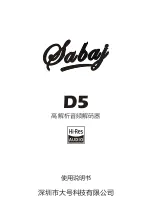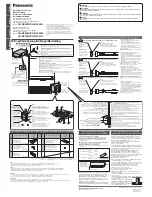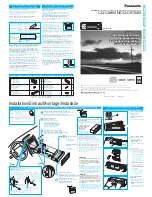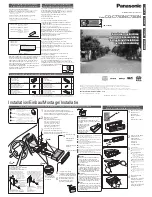
Page 20
Large-scale Decoder & Sound Decoder MX695/6/7/9
Decoder-controlled consisting (a.k.a. "advanced consisting
”)
The combined operation of two or more locomotives (consisting) can be organized by
-
the DCC system (common practice with ZIMO systems, without changing any decoder CV’s) or
-
by programming the following decoder CV’s individually, which can also be managed by some
DCC systems (often the case with American made systems).
This chapter covers only the latter; the decoder controlled consisting!
CV
Designation
Range Default Description
#19
Consist address
0 - 127
0
A consist address common for 2 or more engines can
be entered in this CV to each loco of the same consist.
If CV #19 > 0: Speed and direction is governed by this
consist address (not the individual address in CV #1 or
#17+18); functions are controlled by either the consist
address or individual address, see CV’s #21 + 22.
Bit 7 = 1: Driving direction reversed
#20
Extended consist ad-
dress
From SW version 36.6
0 - 255
0
The value of CV20 multiplied with 100 added together
with the value of CV 19 which result is the address at
consist.
e.g. CV20= 12, CV19=34 is address. 1234
CV20=100, CV19=00 is address 10000
#21
Consist Functions
F1 - F8
0 - 255
0
Functions selected with this CV will be controlled by the
consist address.
Bit 0 = 0: F1 controlled by individual address
= 1: …. by consist address
Bit 1 = 0: F2 controlled by individual address
= 1: …. by consist address
………. F3, F4, F5, F6, F7
Bit 7 = 0: F8 controlled by individual address
= 1: …. by consist address
,
#22
Consist Functions
F9
– F27
and
headlight control
0 - 191
0
Select whether headlights and/or functions F9
– F12 are
controlled via consist address or single address.
Bit 0 = 0: F0 (forw.) controlled by individual address
= 1: …. by consist address
Bit 1 = 0: F0 (rev.) controlled by individual address
= 1: …. by consist address
Bit 2 = 0: F9 controlled by individual address
= 1: …. by consist address
Bit 3 = 0: F10 controlled by individual address
= 1: …. by consist address
Bit 4 = 0: F11 controlled by individual address
= 1: …. by consist address
Bit 5 = 0: F12 controlled by individual address
= 1: …. by consist address
Bit 7 = 1: F13
– F27 (all !) …. by consist address
5.5
Analog operation
All ZIMO decoders are capable of operating in
DC analog
on conventional layouts (with DC
power packs, including PWM throttles)
as well as in
AC analog
(Marklin transformers with high
voltage pulse for direction change).
To allow analog operation
CV #29, Bit 2 = 1
must be set. This is usually the case by default (CV #29 = 14, which includes Bit 2 = 1), but ana-
log operation may be turned off in many sound projects (sound decoders). Check this CV first to
ensure that the analog mode is enabled if the engine won’t run on an analog layout.
It is rec-
ommended to set CV #29, Bit 2 = 0 when operating in a DCC environment only!
The new large scale decoders (MX695/6/7) are very well designed for analog operation because
they can turn on
lights, sound and the motor at a very low track voltage, by "raising” the track
voltage internally to a certain degree. See the chapter titled “Technical Data”. This effect is
achieved by applying stepped threshold voltages that is, the headlights will come on first, the
sound at a slightly higher voltage and only after that will the motor start.
The actual behavior during analog operation however, is strongly influenced by the locomotive
controller (power pack). Especially in conjunction with a weak transformer, it is easy possible
that the track voltage collapses when the decoder (motor) starts to draw power which, in the
worst case, may lead to intermittent performance. There are a number of adjustment possibili-
ties for analog operations
where motor control and function outputs are concerned; these CV’s
can of course be read-out or programmed only with a DCC system or other programming de-
vices.
CV
Designation
Range
Default Description
#13
Analog Functions
F1-F8
0 - 255
0
Defines function outputs that should be “ON” in analog
mode.
Bit 0 = 0: F1 is OFF in analog mode
= 1: …ON in analog mode
Bit 1 = 0: F2 is OFF in analog mode
Bit 1 = 1: …ON in analog mode
………..F3, F4, F5, F6, F7
Bit 7 = 0: F8 is OFF in analog mode
Bit 7 = 1: …ON in analog mode
#14
Analog functions
F9
– F12,
Analog momentum
and
Regulated Analog
0 - 255
64
(Bit 6 = 1)
Defines function outputs that should be “ON” in analog
mode.
Bit 0 = 0: F0 (forw) is OFF in analog mode
= 1: …ON in analog mode
Bit 1 = 0: F0 (rev) is OFF in analog mode
Bit 1 = 1: …ON in analog mode
Bit 2 = 0: F9 is OFF in analog mode
Bit 2 = 1: …ON in analog mode
------------F10, F11
Bit 5 = 0: F12 is OFF in analog mode
Bit 5 = 1: …ON in analog mode
Bit 6 = 0: Analog operation with acceleration and
deceleration according to CV #3 and #4.
Bit 6 = 1: Analog operation without acceleration and
deceleration according to CV #3 and #4.
Summary of Contents for MX695
Page 6: ...Page 6 Large scale Decoder Sound Decoder MX695 6 7 9 ...
Page 7: ...Large scale Decoder Sound Decoder MX695 MX696 MX697 MX699 Page 7 MX697 ...
Page 8: ...Page 8 Large scale Decoder Sound Decoder MX695 6 7 9 ...
Page 14: ...Page 14 Large scale Decoder Sound Decoder MX695 6 7 9 ...
Page 15: ...Large scale Decoder Sound Decoder MX695 MX696 MX697 MX699 Page 15 ...
















































